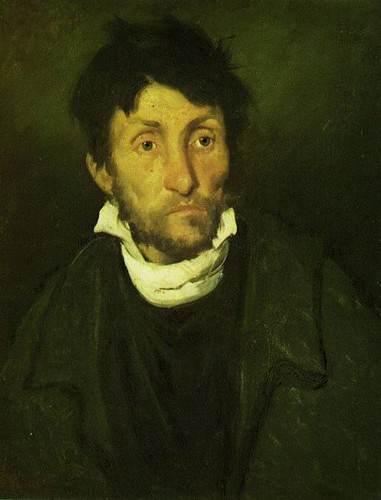One often does not have a clue of the colors of painted artworks if one is an internet connoisseur. By internet connoisseur I mean someone who has gained most of his/her expertise from the internet rather than traditional media. Questions of color fidelity on the internet should be raised here.
Before October 30, 2008 the only version known to me of Géricault’s Kleptomaniac was this one:
Kleptomaniac, 1822 painting by Théodore Géricault
Compare this photo taken at its current location here:
The detail of the painting was taken with a Sony Ericsson K770i on last Thursday.
The Sony Ericsson is notorious for picking up an excess of blue, but still is a rather faithful reproduction.



I faced the same dilemma here:
http://un-certaintimes.blogspot.com/2008/10/restoration.html
Somehow, I satisfied myself with the notion that they had cleaned the accumulated grime off the painting rather than considering the characteristics of the imaging. Shows what I know.
Although I have had some training in art history, visited countless museums, galleries, studios and personal collections, stayed in the home/workshop of an accomplished conservator and pored over numerous art books, I have to admit that I am, of late, shading toward “internet connoisseur”, though I would be reluctant to claim any expertise at all.
The same issues are relevant to knowledge of art gained through reproductions in books. Texture and color are lost and changed. Confronting the original is always the best way, and certainly the most exciting.
Of course, architecture has the same problems. Visiting the Parthenon, the most overheard comment is, “I thought it was bigger.” Photos loss the sense of scale and provide little sense of spatial progression.
So, though reproductions are wonderful [consult one of my favorite books, Prints and Visual Communication by Ivins, to get a sense of what studying art history meant before photoreproduction! (http://iamyouasheisme.wordpress.com/2005/02/01/dots-secrets-of-the-universe/) ] they cannot be taken as faithful.
Thanks for the Barbey post! I have commented on him as the source for the characters of Gomez and Morticia Adams!
Lichanos,
Barbey: I’ve included your summary on my wiki page for Happiness in Crime.
The story also reminds me of Val Lewton’s Cat_People_(1942_film) which I liked a lot.
And look at this: http://en.wikipedia.org/wiki/Image:Weretiger.jpg
Ivins:
I’d spotted the Ivins book Prints and Visual Communication before but never got around to ordering it. One day I will.
John M.
Expertise: I claim a little in order to not show any false modesty :).
J
I cannot praise Ivins’ book too highly. He unwillingness to progress into topics of epistemology is one more point in his favor – he is content to imply and indicate the importance of his writing. He leaves it for his epigones like me to elaborate. Thus, of course, I demand that you read him, or at least my post!!
Really, I’m surprised you came across his book – where? He doesn’t seem much known these days. I would rank his book as THE most stimulating book on art-in-history that I have ever read.
How nice to rant in FAVOR of something! Soon, our election will be over and I can go back to sleep.
He is listed on my page http://www.jahsonic.com/Printing.html (Jahsonic was my site before the wiki)
I quoted:
Wonderful!
I can assure no false modesty here, my knowledge of art is abysmal. It has been a fun journey to learn, however. Perhaps I shall find myself with some expertise, eventually.
It isn’t a strictly internet phenomena. I learned much of my art history from old books–my grandparent’s library. The colors in those old picture books were far from true. Actually, that murky green tint of the Gericault above is quite familiar to me. But at least I had the benefit of rough approximation of color, as opposed to the BW photos used by the generation before me, or the etchings after the original used before that.
When I compare my grandparent’s stack of art books to how many images I have access to via my laptop…it’s staggering. It’s an embarrassment of riches. And think of the 18th century collector who would count himself lucky to have a few portfolios of etchings, and could only guess at the world’s treasures.
Still, there’s nothing like going nose to nose with an original piece of art. (And I’d include in that category the pleasure of seeing films projected from actual film in nice dark cinemas.)